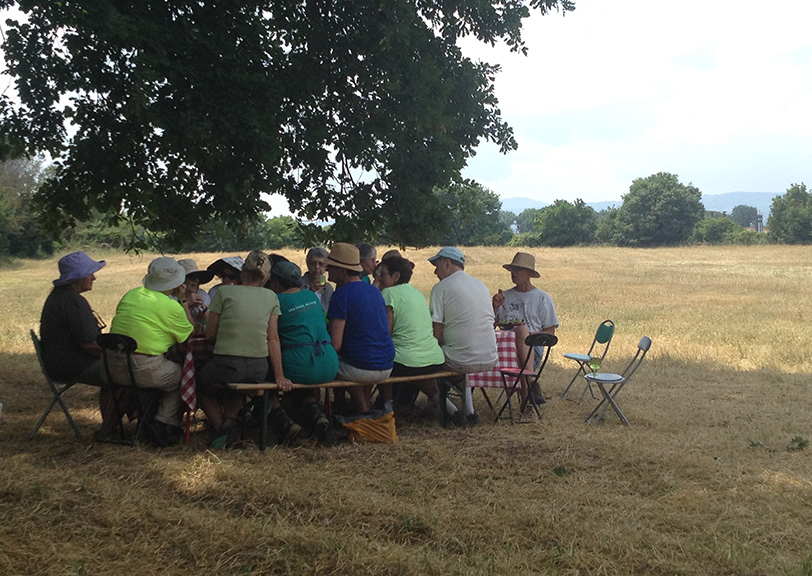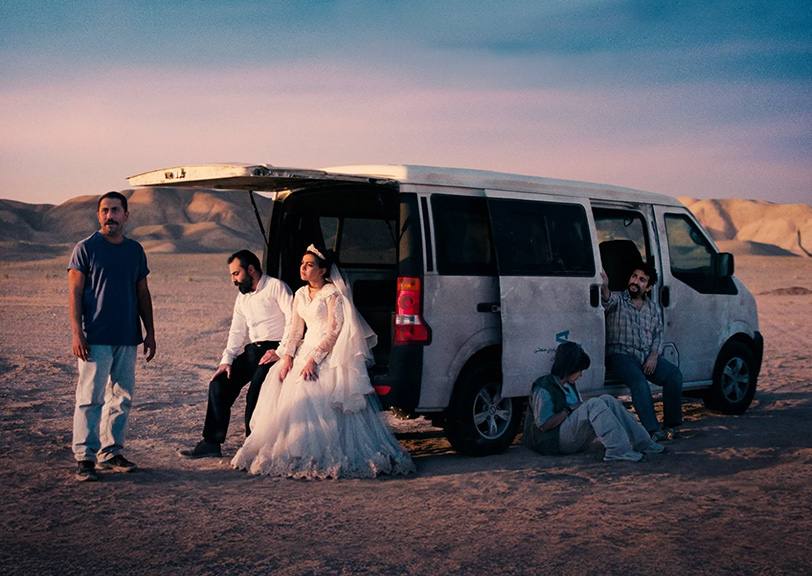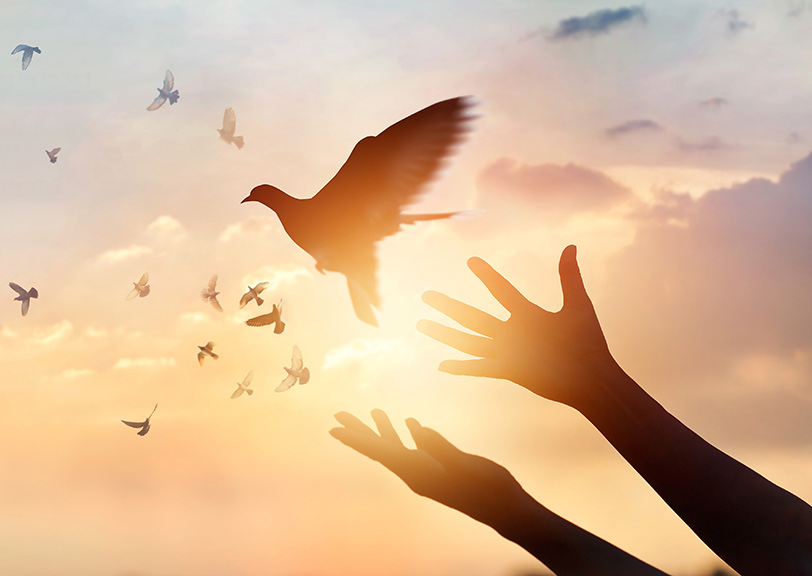ENTER YOUR EMAIL TO RECEIVE OUR WEEKLY NEWSLETTER
Creating a Life (and a Livelihood) in Italy
Here’s how a New York couple accomplished just that—in Tuscany—with plein air painting classes, truffle hunting, and culinary tours
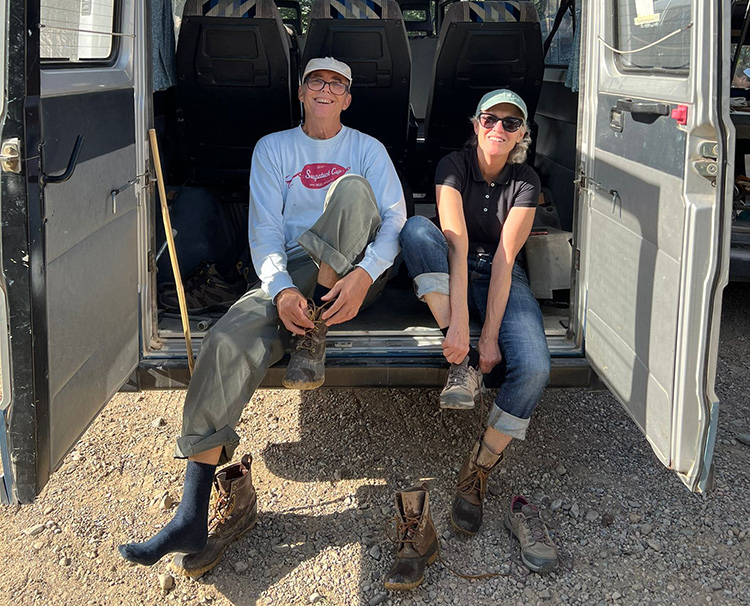
Lacing up: The author and her husband, Joe Vinson, prepare to lead a hike in the Tuscan hills.
. . . . . . . . . . . . .
November 10, 2025
2025 marks a Jubilee year in Italy. In the Catholic tradition, it represents an occasion for reconciliation and spiritual renewal. As it turns out, it is also a milestone year for me.
Thirty years ago, I met my artist husband, Joe Vinson, and we began running landscape-painting workshops and eventually food tours here together. They continue to this day. Every year we spend six months each in our homes in New York City and Tuscany. It has been a rich and dreamlike experience—though from an economic standard it can hardly be described as successful. We live from year to year, making just enough income to continue this rarefied arrangement for one more season. Joe likes to joke, “We are on the get-rich-slow scheme.”
But material wealth has never been my objective. Instead, my goal has been existential.
I first came to Italy in the late 1970s for an undergraduate semester in Florence. Like many young people, I had no clear idea of who I was. While I had always enjoyed both academic and social success, I simultaneously felt solitary and disconnected from the world that produced me. I yearned for something more.
I was an aesthete, though I did not know it at the time. All my impulses were directed to the sensuous: art, literature, music, food, nature. However, the various influences in my upbringing on Long Island led to their subordination to “the practical.” Italy freed them.

On location: Surrounded by sumptuous scenery, a student painter attends to her easel.
. . . . . . . . . . . . .
In my first weeks in Florence, I wandered around in a trance, swooning in the face of so much beauty and antiquity. The assault on my senses was complete: the visual harmony of the architecture and landscape, the melodious sound of the Italian language, the aromas issuing forth from tiny streets, and the universe of flavors in Mediterranean cuisine. I had no money but felt alive and happy in a way I never previously had.
The experience of those months was transformational. I soon realized that the frequently used term quality of life was not a function of financial assets but rather had to do with how we choose to live, making trade-offs for a clear set of guiding principles. Charged by the boldness and innocence of a 20-year-old, I resolved to live steeped in sentiment and beauty. Living in Italy showed me that that could be possible even with modest means. I vowed to stay connected with the country and eventually have a piece of it for myself.
The convoluted path I took to the present from international banking, through the United Nations in Rome, to an MFA in painting from the New York Academy of Art, is a separate saga. The story of how I landed in Italy on the terms set more than 45 years ago began in art school.
In 1995, during my final year of studies, I had to confront the reality that I could not make a living, and certainly not return to Italy, by selling paintings alone. I had spent years of my life as a student, loved learning and the education process in general. My communication skills were good. While living in Rome, I developed a passion for landscape painting. Though lacking in teaching experience, I had a suspicion that this was something I would enjoy. All was suddenly clear: I would use my newly acquired painting skills and business knowledge to organize landscape-painting workshops on my own. Holding them in Italy was the easy part.
I had a close friend who owned a farm in a spectacular location outside San Gimignano, a village in Tuscany known for its medieval towers. He provided accommodation and meals to guests in an early version of a farm stay—a novel experience that was growing in popularity. As a frequent visitor, I got to know the territory well and proposed bringing groups for weekly stays, with meals included. He would incur no promotional costs. I would pay him directly, enabling him to avoid awkward interactions in English, as he spoke only Italian. That was a win-win for both of us.

En route: The quest for truffles proceeds on a winding Tuscan road.
. . . . . . . . . . . . .
I started with a budget of $5,000, a concept for the course and program design, and a major dose of enthusiasm. A single ad placed in an art magazine got me two students—enough to run a pilot class. The results exceeded my expectations and convinced me that I had found my calling. The next year, a journalist friend wrote a tiny article with a map of Tuscany that appeared in the Sunday Travel section of The New York Times. And as it happened, Tuscany was on everyone’s radar following the 1996 publication of Frances Mayes’s memoir Under the Tuscan Sun. The response was overwhelming; every class that season filled up. Having seen the Times piece, an entrepreneur contacted me about setting up a free website for the class. The internet was just getting started, and he needed sample sites to promote his new business. Landscapepainting.com was off and running.
Within two years, to satisfy the demand for a “return experience,” I introduced another course, with completely different content, in a new location—Montalcino. When that course quickly oversubscribed, this burgeoning business seemed stable enough for Joe to join me. We had recently married, and, like me, he wanted to focus his life and career on painting. He quit his job, and the most creative phase of our program design began.
Joe and I are fortunate in that we are both curious individuals who share a love for art, history, archaeology, travel, and food. Italy is a mecca for all of these. We spent our first years exploring: deepening our knowledge of the country, the itineraries of early outdoor painting, and traditional Tuscan culture with its agrarian roots and centuries-old practices of small-scale farming and animal husbandry. Nothing thrilled us more than traveling to a remote location in search of a historic landscape, a work of art, an ancient monument, or a gastronomic delight. And in the course of these adventures, we built a network of relationships and acquired a wealth of information about Italy.
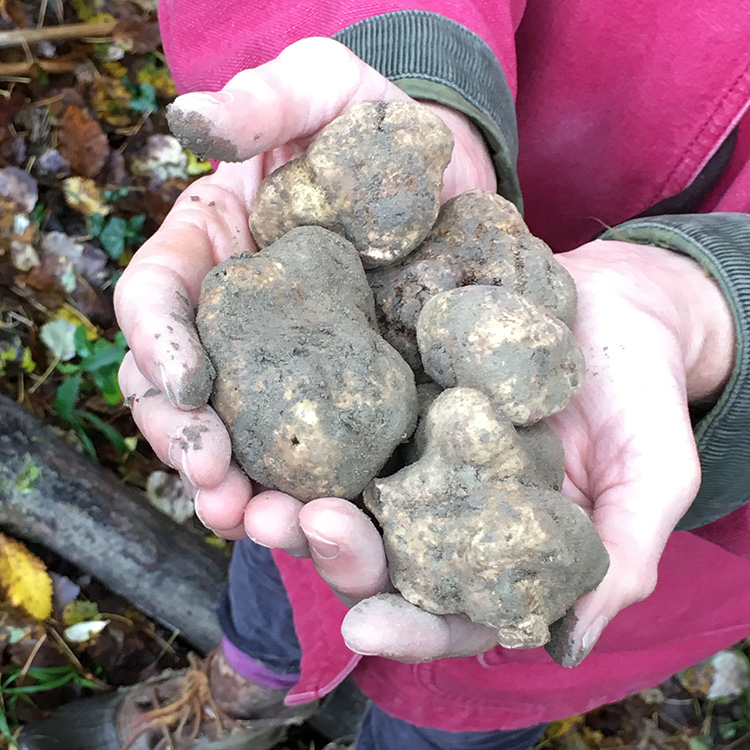
Earthy splendor: White truffles—freshly picked and sizable—rate a photo op after a particularly successful hunting day.
. . . . . . . . . . . . .
We bought and renovated an apartment in the historic center of Buonconvento, a Tuscan village off the path of mass tourism. We knew the area but until the day we moved in were completely unaware that we had landed in the white truffle capital of central Italy.
While searching for ingredients to make our first meal, we passed a fruit-and-vegetable vendor with a handwritten sign in the window announcing tartufi nostri (“local truffles”). The excessive rain that year had compromised the local wine harvest but produced a bumper crop of truffles. We purchased a golf-ball-size fungus, fresh pasta, butter, a bottle of Brunello di Montalcino, and headed home to inaugurate our new life.
When Joe and I decided to leave everything behind and work together, we figured the painting workshops would be a stable source of income. Wrong! By 2004 it was clear that every major political and economic event had an effect on enrollment. Our revenues were vacillating wildly and unpredictably. We needed to find something to offset this risk. And it turned out the solution could not have been more obvious: Take advantage of our home in a white truffle zone and production center of world-class wine, award-winning olive oil, artisanal cheeses and meats, and create a food-and-cooking tour!
From its initial concept, the Tuscan White Truffle and Brunello tour did not take long to design and market. We already knew the parties we wanted to work with and could easily secure more introductions. Between growing up with Sicilian grandparents, waitressing in restaurants as a college student, and 25 years of living in Italy between 1978 and 2004, I was a confident cook and knew quality. Our apartment was large enough to host cooking classes. Participants would be lodged nearby.
Our objectives in designing the tour were straightforward and modest: present an authentic experience of Tuscany, its wine and cuisine; work with small-scale producers committed to traditional methods; offer nothing less than what we would expect for ourselves; and offer it to no more than ten participants (the maximum number we can seat at our table in Buonconvento!), only once a year. We wanted the food tour to be singular, a work of art in itself, and something we too could enjoy.
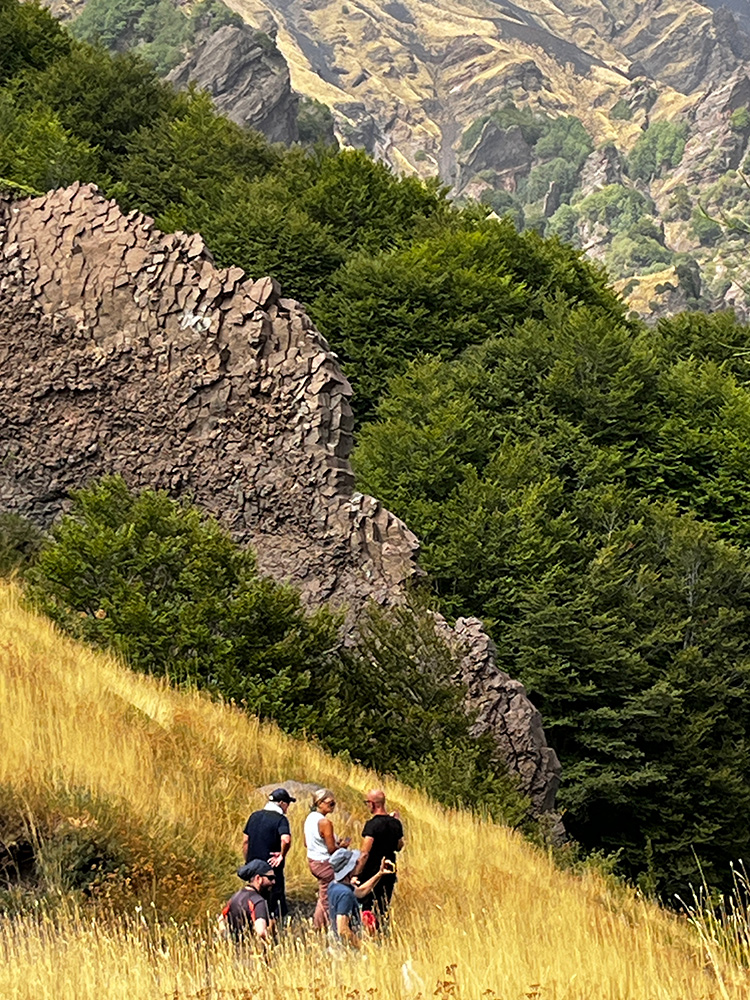
On the heights: A group of hikers take a break on Mount Etna.
. . . . . . . . . . . . .
Our passion for eating and traveling, combined with a desire to explore my heritage, led in 2019 to a Sicily tour, Under the Volcano: Nature, Culture, and Gastronomy. While its scope and design are similar to the Tuscan tour’s, its focus is on the territory around Mount Etna and the connections between nature and culture.
The participants of all of our programs come primarily from the United States and have diverse backgrounds. We have hosted opera singers, plastic surgeons, magazine editors, college professors, and kindergarten teachers. The age range varies but tends to be between 40 and 75. Due to the hiking involved—in truffle-hunting in Tuscany and on Mount Etna and in archaeological treks in Sicily—the food tours have a fitness requirement.
Working with a variety of attendees with different personalities and in close quarters—for a week—is demanding. Painting workshops are easier to manage than culinary tours, as the common interest in art makes a group naturally more harmonious. The social overload is also reduced as painters spread out across the landscape for hours at a time. Since most of our guests are not accustomed to dining repeatedly with unfamiliar faces, the food tours are trickier. To meet this challenge, Joe and I have developed our skills as what is described in Italian as animatori. The literal translation of the word is “activity leaders.” However, its root, anima, means “soul.” And, in fact, it is our job to find ways to communicate with others, to make them comfortable, and to engage them in group conversation. We have to go beneath the surface, in the direction of the soul and identity, in order to find a connection. That ability came naturally to us.

Sicilian repast: Lunch on Mount Etna.
. . . . . . . . . . . . .
Looking back at the 30th anniversary of the first painting workshop and meeting Joe, I feel awe at what we were able to create with few resources, big ideas, and love. We developed expertise in a niche area of art history, which led to previously unimaginable opportunities: curation of museum exhibitions, lectures, publications, and an important art-historical discovery. The food tours have allowed us to pursue this obscure passion while indulging in some of Italy’s finest delicacies. We have met all kinds of people whom we would never have come across otherwise. Many of them have become our good friends.
I have frequently been told that our programs—in particular the painting experiences—are inspiring, even life-changing. Truthfully, I am the inspired one. The opportunity to give form to my aesthetic vision and creatively share it with others in Italy has been a continuous source of purpose and meaning in my life; it is fulfilling beyond measure. It has also transformed the way I see the world. Working with so many people of different ages, backgrounds, and ideas has allowed me to see the common threads running through all of us. I have gained a profound appreciation of the connectedness of everything, everyone, everywhere. This insight has made me more open, expansive, honest, and compassionate.
In this personal Jubilee moment, I could not feel more grateful.
Maddine Insalaco is a painter who usually divides her life between New York and Tuscany, where she organizes landscape painting workshops and gastronomic tours with her artist husband. Instagram: @maddine_insalaco.
You may enjoy other articles by Maddine Insalaco:
I’ll Never Forget … Ella Fitzgerald’s Final Concert at Carnegie Hall, 1991


